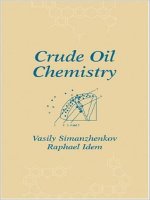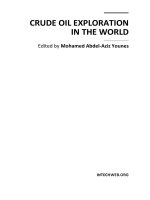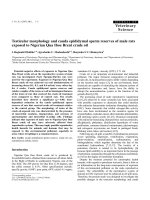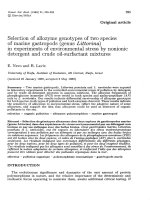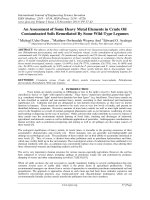crude oil chemistry by vasily simanzhenkov
Bạn đang xem bản rút gọn của tài liệu. Xem và tải ngay bản đầy đủ của tài liệu tại đây (17.37 MB, 411 trang )
Crude
Oil
Chemistry
Vastly
Simanzhenkov
University
Duisburg-Essen
Duisburg,
Germany
Raphael
Idem
University
of
Regina
Regina, Saskatchewan,
Canada
Copyright © 2003 by Marcel Dekker, Inc. All Rights Reserved.
Although
great care
has
been taken
to
provide accurate
and
current
information,
neither
the
author(s)
nor the
publisher,
nor
anyone else
associated
with this
publication,
shall
be
liable
for
any
loss, damage,
or
liability
directly
or
indirectly caused
or
alleged
to be
caused
by
this
book.
The
material contained herein
is not
intended
to
provide specific advice
or
recom-
mendations
for any
specific situation.
Trademark notice: Product
or
corporate
names
may be
trademarks
or
registered trademarks
and are
used only
for
identification
and
explanation without
intent
to
infringe.
Library
of
Congress
Cataloging-in-Publication
Data
A
catalog record
for
this
book
is
available from
the
Library
of
Congress.
ISBN:
0-8247-4098-X
This book
is
printed
on
acid-free
paper.
Headquarters
Marcel Dekker, Inc.,
270
Madison Avenue,
New
York,
NY
10016,
U.S.A.
tel:
212-696-9000;
fax: 212-685-4540
Distribution
and
Customer Service
Marcel Dekker,
Inc.,
Cimarron
Road, Monticello,
New
York
12701,
U.S.A.
tel:
800-228-1160;
fax: 845-796-1772
Eastern
Hemisphere Distribution
Marcel Dekker
AG,
Hutgasse
4,
Postfach 812,
CH-4001
Basel, Switzerland
tel:
41-61-260-6300;
fax:
41-61-260-6333
World Wide
Web
The
publisher
offers
discounts
on
this book when ordered
in
bulk quantities.
For
more
infor-
mation, write
to
Special Sales/Professional Marketing
at the
headquarters address above.
Copyright
©
2003
by
Marcel Dekker, Inc.
All
Rights
Reserved.
Neither this book
nor any
part
may be
reproduced
or
transmitted
in any
form
or by any
means, electronic
or
mechanical,
including
photocopying, microfilming,
and
recording,
or
by any
information
storage
and
retrieval system, without permission
in
writing
from the
publisher.
Current printing (last digit):
10987654
3 2 1
PRINTED
IN THE
UNITED
STATES
OF
AMERICA
Copyright © 2003 by Marcel Dekker, Inc. All Rights Reserved.
Preface
This
book
is
devoted
to
students
as
well
as
scientists
and
process
engineers
in-
volved
in
petroleum science,
refining
and
engineering. Part
I of the
book gives
a
historical
overview
of the
origin
of
petroleum.
The first
chapter shows
how
crude
oil
is
linked with human civilization.
In
this chapter
it is
also
shown that
the en-
ergy
used
to run
most
of
today's machinery derives
from
petroleum.
It
also pro-
vokes
our
imagination
on how the
various moving parts
of
machinery would oper-
ate
without mineral
oil or
lubricating oil, both
of
which
are
also produced
from
crude
oil.
The
first
chapter
also
provides
insight into
the
problems
that
have
arisen
as a
result
of
applying
different
standards
by
different
countries
to
similar crude
oil
products
and how
these problems
are
tackled.
The
second chapter
of
Part
I
deals
with
modern analytical methods used
in
crude
oil
chemistry. Modern
and
classical methods
of
petroleum
and
petroleum product
characterization
are
explained. This chapter
is an
essential chapter
for
present
and
potential
crude
oil
chemists
since
analytical chemistry constitutes
an
important
part
of
crude
oil
chemistry. Besides, crude
oil
products have
so
many special
properties that
are
important
for the
industry.
The
need
to
determine these proper-
ties gives rise
to the use of
very many analytical methods
in the
petroleum indus-
try.
Part
II
(i.e. chapters
3 and 4)
shows
the
geopolitical
and
economic nature
of pe-
troleum chemistry.
In
this
chapter,
the
initial
stages
of
development
of
various
petroleum companies
are
shown.
It
gives
a
historical run-down
on how
small
companies
of the
past have blossomed into giant multinational companies
of
worldwide repute.
For
readers,
it is
especially interesting
to
learn
the
history
of the
development
of the
Eastern Bloc companies, especially
the
Russian companies.
In
this
chapter,
it is
shown
how the
political situation
in
this country
has had a
great
influence
on the
economic development
of all
Russian industries
in
general
and
the
petroleum industry
in
particular.
It is
also
shown
how it has
been
possible
for
the
big
Russian petroleum concerns
to be
formed
in
less than twenty years during
the
difficult
times
of
political
and
economic reforms.
Chapters
5 and 6 of
Part
III of the
book introduce
the
reader
to the
science
of
crude
oil
refining.
An
illustration
of the
complete process scheme that starts
from
crude
oil
all the way to final
products
is
given.
In
particular,
the
process route
of
crude
oil
from the
well
to the gas
station
and
indeed
the car
tank
is
provided.
These
chapters also present
the
techniques
and
technologies involved
in
most
of the im-
portant
processes
used
in
modern petroleum refineries
for
processing light
and
heavy
distillate fractions. Chapter
7 in
Part
III
looks
at
ecological problems that
Copyright © 2003 by Marcel Dekker, Inc. All Rights Reserved.
arise
in the
crude
oil
industry.
The
chapter also shows that,
in
order
to
develop
an
appropriate technology
for
crude
oil
treatment,
not
only
are
economically rational
decisions required,
but
also, ecologically acceptably decisions
are
needed.
This
chapter looks
at our
environment
as a
very sensitive system
that
must
be
protected
with respect
to the
many processes that take
place
in the
petroleum refining indus-
try.
Good quality crude
oil is
often
defined
in
terms
of
high
API
gravity
and low
sulfur
content. However, reserves
of
this type
of oil are
disappearing, giving rise
to in-
creasing
contributions
from oil of
lower
API
gravity
and
higher
sulfur
content.
Is
the
chemistry
of
processing
of the two
types
of oil
different?
This question
is an-
swered
in
Part
IV of
this book.
The
chapter also introduces
the
presence
of
asphal-
tenes
in
crude oil.
A
list
of
problems that occur during
oil
production, transporta-
tion,
and
processing
that
could
be
attributed
to
asphaltene
presence
in
crude
oil is
presented.
New
concepts
and
approaches that
aid in the
processing
of
crude oils
with
significant amounts
of
asphaltenes
are
introduced. Part
IV
also looks
at
future
processes that
may be
introduced
in the
petroleum refinery.
These
are
hybrid
fuel
production processes that involve combining
the
well-known modern cracking
process
with
the
recycling
of
waste plastics
or
bio-fuels.
The
advantages than
can
be
derived
from
co-processing
of
asphaltene-containing crude oils with plastics
or
biomass
materials
are
given. Part
IV
also
presents
some analytical techniques that
could
be
used
by
petroleum engineers
and
chemists
to
better understand
the
nature
of
heavy crude
oil and
residues,
and
possible ways
to
positively influence their
processing.
In
all, Part
IV
presents critical material that
can
contribute towards
further
development
of the
petroleum industry.
This
is
especially true
for the
non-
conventional petroleum industry,
and it can be
particularly important
for
North
America, since Canada
has the
largest reserves
of
non-conventional petroleum
in
the
world.
Both authors have worked extensively
in the
areas
of
petroleum science
and
engi-
neering.
We
hope that this book will
go a
long
way in
introducing
the
reader
to the
fascinating
world
and
concepts
of the
black gold
of our
planet.
Vasily
Simanzhenkov
Raphael
Idem
Copyright © 2003 by Marcel Dekker, Inc. All Rights Reserved.
Contents
Preface
Part
I
Classification
and
Characterization
of
Crude
Oil
1
Nature
and
Classification
of
Crude
Oil
1.
History
and
nature
of
petroleum
1. .1
Origin
of
petroleum
1. .2 Oil
formation
in the
world's
oceans
1. .3
Modern concept
of
formation
of
petroleum
1. .4
Consequences
of
intensive
extraction
and
processing
of oil
1.
.4.1 Dangerous fogs
1.
.4.2 Black oceans
1.2
General properties
and
classification
of
petroleum:
comparison
of
petroleum
from
different
countries
1.2.1
Fractions
and
chemical composition
of
petroleum
1.2.2 Chemical classification
of
petroleum
1.2.3 Classification
by
density
1.2.4 Characterization
by
viscosity-gravity
constant (vgc)
1.2.5 Technological classification
of
petroleum
1.3
Products from crude
oil
1.3.1 Gasoline
1.3.2
Jet
fuel
(kerosene)
1.3.3 Diesel
.3.4 Residual
fuel
.3.5 International standards
for
fuels
.4
Lubricating oils
and
lubricants
.4.
International standards
for
lubricating oils
.4. . 1
Industrial oils
.4. .2
Motor oils
.4. .3
Transmission oils
.4. .4
Hydraulic
oils
2
Modern Characterization
and
Analysis Techniques
for
Crude
Oil
2.1
Chromatographic
methods
2.1.1
Gas
chromatography
2.1.2 High performance liquid chromatography
2.1.3 Thin layer chromatography
2.2
Spectroscopic methods
2.2.1 Infrared spectroscopy
Copyright © 2003 by Marcel Dekker, Inc. All Rights Reserved.
2.2.2 Raman spectroscopy
2.2.3 Colorimetry
and
photometry
2.2.4 Fluorescence
and
phosphorescence spectroscopy
2.2.5 Atomic absorption spectroscopy
and
atomic emission
spectroscopy
2.2.6 X-ray
fluorescence
spectroscopy
2.3
Other methods
for
elucidating
the
structure
of
crude
oil
2.3.1 Separation methods
2.3.2 Chemical analysis methods
of
crude
oil
products:
determination
of
unsaturated compounds
2.3.3 Structural bulk
analysis
of
heavy crude
oil
fractions:
n-d-M method
2.4
Methods
of
characterization
of
colloidal properties
of
crude
oil
and
its
products
2.4.1 Direct methods
2.4.2 Indirect methods
2.5
Determination
of the
physical properties
of
crude
oil
2.5.1 Density determination
2.5.2 Viscosity determination
2.5.3 Refractive index determination
Bibliography
Part
II
Regional Petroleum Industry
3
Petroleum Producing Countries:
OPEC
and
Non-OPEC
3.1
Introduction
3.1.1 Short background
on
OPEC
3.2
North
America
3.2.1 United States
3.2.2 Canada
3.3
Russia
3.3.1
The
role
of the
petroleum industry
for
Russia
3.3.2 Reforms
in the
Russian
oil
industry
3.3.3 Russian petroleum
and gas in the
world market
3.3.4
Structure
of
the
petroleum sector
in
Russia
3.4
Arabian East
3.4.1 Oman
3.4.2 Iraq
3.4.3 Iran
3.4.4
Qatar
3.4.5 Kuwait
3.4.6 United Arab Emirates
3.4.7 Saudi Arabia
Copyright © 2003 by Marcel Dekker, Inc. All Rights Reserved.
4
International Petroleum Companies
4.1
British Petroleum
4.2
Castrol
4.3
ExxonMobil
4.4
Neste/Fortum
4.5
Shell
4.6
Total
/Fina/
Elf
4.7
LUKOil
4.8
Yukos
4.9
TNK
Bibliography
Part
III
Main
Processes
in the
Petroleum
Refining
Industry
5
Crude
Oil
Distillation
5.1
Petroleum
and gas
preparation
5.1.1
Formation
of
petroleum emulsions
and
their basic properties
5.1.2 Separation
of
water-oil
emulsions
5.1.3 Mechanical petroleum drying
5.1.4 Thermal petroleum drying
5.1.5
Chemical methods
of
petroleum drying
5.1.6 Thermal chemical petroleum drying
5.1.7 Stabilization
of
petroleum
5.1.8
Technological schemes
for
petroleum preparation
5.1.9
Pressure extraction system
5.2
Desalting
5.3
Atmospheric rectification
5.4
Vacuum rectification
5.5
Heat exchangers
and
separators
6
Processing
of
Light
and
Heavy Distillates
6.1
Thermal cracking
6.2
Catalytic cracking
6.3
Visbreaking
6.4
Coking
6.5
Hydroprocessing
6.6
Reforming
6.7
Isomerization
6.8
Alkylation
6.9
Blending
7
Environmental Issues Facing
the
Refining
Industry
7.1
Introduction
7.2
Methods
of
cleaning crude
oil
contaminated water
and
soil
Copyright © 2003 by Marcel Dekker, Inc. All Rights Reserved.
7.3
Methods
of air and gas
cleaning used
in the
crude
oil
industry
7.4
Conclusion
to
Part
III
Bibliography
Part
IV
Heavy
Oil
Processing
-
Chemistry
of
Asphaltenes
8
Chemistry
of
Crude
Oil
Asphaltenes
8.1
Introduction
8.2
Problems
of
crude
oil
residue treatment with
respect
to
asphaltenes
8.2.1 Coke formation
and
reduction
of
heavy metals
8.2.2 Treatment possibilities
for
crude
oil
residues
8.2.2.1 Physical treatment
-
deasphalting
8.2.2.2
Chemical
treatments
8.2.2.3
Visbreaking
8.2.2.4
Coking
8.2.3
Coke
forming reactions during residue treatment
8.2.3.1 Catalytic
treatment
8.2.3.2
Thermal treatment
8.3
Methods
of
analysis
of
crude
oil
residue
8.3.1
Methods
and
main
definitions
for the
determination
of
coke formation tendency
8.3.2 Analytical characterization
of
heavy
oil
residues
and
asphaltenes
8.3.2.1 Solution analysis
8.3.2.2
Coagulation analysis
8.3.2.3 Distillation method
8.3.2.4
Chromatography
8.3.2.5
B
C-NMR
analysis
8.3.2.6 Ultimate analysis
8.3.2.7
Molecular weight determination
8.3.3 Temperature
influence
on
molecular weight determination
9
Processing
of
Heavy Crude Oils
and
Crude
Oil
Residues
9.1
Introduction
9.2
Chemistry
and
reaction
of
asphaltenes during co-processing
of
crude
oil
residue
and
plastics
9.2.1
Change
of
asphaltene structure during thermal processing
9.2.2 Evaluation
of
possibilities
of
various asphaltene reactions based
on
thermodynamics
9.2.3 Hydrogen
transfer
9.3
Co-processing
with
cracked products
9.3.1
Co-processing with cracked products from
aromatics
containing
plastics
(e.g. polystyrene)
9.3.2 Co-processing
with
cracked products from plastics containing
Copyright © 2003 by Marcel Dekker, Inc. All Rights Reserved.
paraffin
groups
9.3.3 Possibilities that exist
for
carrying
out
co-processing
of
heavy
crude oils
and
various co-feeds
9.3.4 Behavior
of
heavy metals during co-processing
9.3.5 Conclusions
of
co-processing
of
crude
oil
residue
and
co-feed
9.4
Industrial methods
of
crude
oil
residue treatment
9.4.1 Fluid catalytic cracking
9.4.2
Hydrocracking
9.4.3 Coking
Bibliography
Appendix
A:
Conversion
Factors
Important
for
Crude
Oil
Chemists
Appendix
B:
Glossary
Copyright © 2003 by Marcel Dekker, Inc. All Rights Reserved.
Parti
CLASSIFICATION
AND
CHARACTERIZATION
OF
CRUDE
OIL
OVERVIEW
In
this part
of the
book,
fundamental
chemical information
of
interest
to
petroleum chemists
is
given.
The first
chapter deals with
the
main definitions
as
well
as the
important properties
of
crude
oil and
petroleum products used
by
petroleum specialists.
A
short history
is
given
as to how
crude
oil
became
the
most
important
power source
for our
civilization
for
over thousands
of
years.
A
short
discussion
is
also given
on the
ecological
consequences
of
crude
oil
production
and
treatment
as
well
as
problems that generally arise
in the
petroleum
industry
which crude
oil
chemists have
to
confront.
A
detailed
discussion
on the
properties
of
crude
oil and
crude
oil
products
and
some methods
for
their
improvement prepares
the
reader
for the
problems
the
crude
oil
chemist faces daily. Some early traditional solutions
for
these problems,
which
never became popular
at the
industrial scale,
will
show
the
reader
that there
are
many yet-to-be-researched ways
to
improve
the
methods
for
crude
oil
treatment.
This chapter also
highlights
the
general chemistry
of
crude
oil and
crude
oil
products.
The
last chapter (i.e. chapter
2) of
Part
I
deals with modern analytical
methods used
in
crude
oil
chemistry. Modern
and
classical methods
of
petroleum
and
petroleum products characterization
are
explained. This chapter
is an
essential
chapter
for
present
and
potential crude
oil
chemists since analytical chemistry
constitutes
an
important part
of
crude
oil
chemistry. Besides, crude
oil
products
have
so
many special properties that
are
important
for the
industry.
The
need
to
determine
these
properties
gives
rise
to the
very many analytical methods used
in
petroleum chemistry.
Copyright © 2003 by Marcel Dekker, Inc. All Rights Reserved.
1
Nature
and
Classification
of
Crude
Oil
1.1
HISTORY
AND
NATURE
OF
PETROLEUM
Petroleum
or
crude
oil has
been known
for a
long
time.
Archeologists
have
shown that
it had
already been extracted
and
used
for
about
5-6
thousand years
before
Christ.
The
most ancient known
oil
wells
are
those
at
Ephrata
and the
Kerch
coast
in the
Chinese province
of
Sychuan.
The
mention
of
petroleum
has
been found
in
many
ancient
manuscripts
and
books.
For
example,
the
Bible
writes
about
"pitch wells
in the
vicinities
of the
Dead Sea".
In
ancient times, petroleum
had
some applications
in
medicine
as
well
as
civil works.
For
example,
the
ancient Greek scientist Hippocrates
(IV-V
century
B.C.)
has
described many recipes
of
medicines which included petroleum.
In one
ancient manuscript
is
written:
"we
shall
rub the
patients with petroleum
in
such
a
way
that
the
illness
is
taken away. White petroleum takes away
the
illness
(cough
in
this case). Black petroleum takes away
a
reasoning
of the
cough".
The
Egyp-
tians
used petroleum oils
to
manufacture preservation mixtures.
Petroleum
was
also widely applied during construction work. Petroleum
bitumen
was
added
to
cement
and the
resulting product used during
the
con-
struction
of the
tower
of
Babylon.
In the
Bible, there
is a
narration that goes:
"Also
each
other
has
told
to
each
other:
"we
shall
do
bricks
and
heat
it by fire".
And
they used
the
bricks instead
of
stones,
and
earthen pitch instead
of
cement".
Modern chemical analyses show that "earthen pitch"
is
"asphalt",
the
viscous
resinous substance remaining
after
the
natural evaporation
of the
light
fractions
from
petroleum. Asphalt
was
applied
in the
construction
of the
Great Chinese
Wall
as
well
as the
trailing gardens
of
Semiramida.
It was
used
as a
water-
resistant
medium
for the
construction
of
most
of the
ancient dams
on
Ephrata
Copyright © 2003 by Marcel Dekker, Inc. All Rights Reserved.
River.
In the
ruins
of the
ancient Indian
city
Mohengo-Daro
was
found
a
huge
pool
constructed
five
thousand years ago.
The
walls
of the
pool were covered
with
a
layer
of
asphalt.
However,
the
greatest glory petroleum
got was not for its use for
construc-
tion.
For
more than
two
thousand years, petroleum
was
applied
in
military actions
and
served
as a
source
of
military power. This
was
found
in the
discovery
of the
antiquity
based
on the
invention
of
"Greek
fire".
This
new
kind
of
weapon consid-
erably strengthened
the
military power
of the
countries that knew
how to
make
and
operate
them.
It is
still
not
proven scientifically
who
first
invented
the
napalm.
Some people attribute
the
invention
to the
Byzantium alchemists, while others
think
that
the
secret
of its
preparation
was
already known
in
ancient Greece.
The
Greeks used
to
bind
a
vessel with
a
mysterious mixture
to the end of a
stick,
and
threw
it
with
the
huge
fire.
Historians indicate that
the
fire
flew
with
the
speed
of
light
and
with
sound
of
thunder.
When
this
vessel
impinged
on the
wall,
an
explo-
sion occurred that gave rise
to a
huge cloud
of
smoke.
The
flame
was
distributed
in
all
directions.
Water
could
not
extinguish this
fire.
Byzantium
won a lot of fights
using
"Greek
fire". The
antic napalm
was
especially
of
great service
to
Byzantium
in the VII
century during
the
attack
by
the
Arabs
on
Constantinople.
The
Arabian
fleet had
besieged
the
capital
of
Byzantium. Besieged inhabitants
of
Constantinople
had
lost
any
hope
of
rescue
when
the
great idea came. During
one of the
attacks, they allowed
most
of the
Arabian
fleet
to
come
very
close
and
unexpectedly unleashed
a
huge quantity
of
"Greek
fire" on the sea and
burned
it. The flame
burned
all the
Arabian ships.
It
seemed
as if the sea was
burning.
The
composition
of
"Greek
fire" was
kept
as a top
secret. However Ara-
bian alchemists solved
the
secret
of the
"Greek
fire"
after
almost
four
hundred
years
after
the fight at
Constantinople.
The
main component
of
"Greek
fire" was
petroleum
with
the
addition
of
sulfur
and
saltpeter.
Up
till now, petroleum
has
been used
in
many branches
of
construction
work
or
military service.
It is
thus hard
to
imagine what
our
life
today would
be
without crude oil.
It
brings power
to all our
machines
and our
houses.
It is
used
as
a
lubricant
for
various parts
of
machines. Hardly
any
modern device would
work without relying
on
various products derived
from
crude oil.
Even
though
the
history
of
crude
oil
could
be
traced back
by
more than
two
thousand years, real production
of
crude
oil
perhaps began
in
August
27,
1859,
when
the first
industrial-scale crude
oil
well with
a
depth
of 22
meters
was
opened
in Oil
Creek, Pennsylvania.
After
this
first
industrial crude
oil
well
was
opened,
there
was the
commencement
of a
rapid
development
of
crude
oil
production
and
treatment. Probably, this
day
could
be
said
to
mark
the
birth
of
modern crude
oil
chemistry.
In
1878,
the
Swedish businessman
Alfred
B.
Nobel
together with
his
brothers formed
the
Naphtha Company Brothers Nobel.
The
company extracted
the
crude
oil in
Baku, Russia
and
transported
it to the first
crude
oil
refineries
via the
pipelines built
by
Naphtha Co., which still exists
now.
Copyright © 2003 by Marcel Dekker, Inc. All Rights Reserved.
It
may
sound strange
but
petroleum
refers
to a
mountain mineral.
It
usually exists together with sand, clay,
stone,
salt, etc.
We
normally think
of a
mineral
as a firm
substance. However, there also exist minerals
in the
liquid
form
and
even
in the
gaseous form.
One
important property
of
petroleum
is its
ability
to
burn. Other minerals
that
have this property
are
peat, brown
and
stone
coal,
and
anthracite.
These
combustible minerals
form
the
special
family
of
minerals named
"caustobolites"
(derived
from
the
Greek words
causthos,
combustible; bios,
life;
cast, stone) meaning combustible organic stone
[1].
There
is a
distinction between coal caustobolites
and
petroleum caustobolites.
All
caustobolites, however, contain
carbon,
hydrogen
and
oxygen even
though
in
different
proportions
for
different
caustobolites. Specifically, petroleum
is
a
complex mixture
of
hydrocarbons
and
other carbon compounds.
At the
ele-
mental level,
it
consists
of
elements such
as
carbon (84-87%)
and
hydrogen
(12-
14%)
as
well
as
oxygen,
nitrogen
and
sulfur
(1-2%).
The
sulfur
content
can
some-
times
be up to
3-5%. Overall, petroleum
consists
of
hydrocarbons, asphaltenes
and
resins,
paraffins,
sulfur
and
ash. There
are
three main groups
of
hydrocarbons
in
petroleum—namely,
paraffinic,
naphthenic
and
aromatic hydrocarbons
[2].
The
paraffinic
series
of
hydrocarbons have
the
general formula
C
n
H(
2n
+2)
and
can
be
either straight chains (normal)
or
branched chains (isomers)
of
carbon
at-
oms.
The
lighter, straight-chain
paraffins
are
found
in
gases
and
paraffin
waxes.
Examples
of
straight-chain
paraffinic
hydrocarbons
are
methane, ethane, propane,
and
butane (gases containing
one to
four
carbon atoms, respectively),
and
pentane
and
hexane
(liquids with
five and six
carbon atoms, respectively).
The
branched-
chain
(isomer)
paraffins
are
usually
found
in the
heavier fractions
of
crude oil.
They usually have higher octane numbers than
the
normal
paraffins.
Paraffinic
hydrocarbons
are
saturated compounds with
all
carbon bonds saturated (i.e.,
the
hydrocarbon
chain carries
the
full
complement
of
hydrogen atoms).
The
amount
of
paraffins
in
different
crude
oils
varies
from 2 to
50%.
The
light
paraffins
are
mainly components
of
natural gas, which dissolve
in the
crude
oil
in the oil
wells. Depending
on the
composition
and
conditions
in the oil
well,
one
can
specify
well classes such
as gas
wells,
gas
condensate wells
and
crude
oil
wells.
Gas
wells contain mainly such light
paraffins
as
methane, ethane, propane
and
butane,
all of
which
are
gases
at
normal conditions
(0.1
Mpa and 20
°C). Apart
from
these hydrocarbon gases,
gas
wells also contain carbon dioxide
(CO
2
),
hy-
drogen
sulfide
(H
2
S)
and
inert gases such
as
nitrogen
(N
2
),
argon
(Ar),
helium
(He),
neon
(Ne)
and
xenon (Xe).
Often,
gas
condensate wells contain compounds with higher molecular
weights than compounds
of gas
wells.
At
natural conditions
in the oil
well (pres-
sures ranging
from
25 to 45
MPa), these high molecular weight compounds
dissolve
the
gas. Initially during
oil
production
from gas
condensate wells, pres-
sure
will decrease thereby releasing
the low
molecular weight compounds
and
leaving
the
high
molecular
weight
compounds
behind.
This
high
molecular
weight
fraction is
called condensate.
Copyright © 2003 by Marcel Dekker, Inc. All Rights Reserved.
Crude
oil
wells contain crude
oil as
well
as
gas.
The
amount
of gas in the
crude
oil
varies
from
very little
to
hundreds
of
cubic meters
per ton of
crude oil.
These gases, solved
in
crude oil,
can be
released
from
the
crude
oil at
normal
pressures.
After
production, crude
oil is
stabilized
by
separating
the gas
from
the
oil
(see Part III).
The
crude
oil
coming
to the
refinery usually contains less
than
1%
of
dissolved gas.
All
paraffins
from
C,
to
C
7g
can be
separated
from
crude oil. However,
it
has
been shown that
the
largest
fraction
of
paraffins
in the
crude
oil is
composed
of
molecules
from
€7
to
CM-
Lighter
or
heavier paraffins
are
present
in
crude
oil
in
smaller amounts
or as
trace compounds.
All
types
of
paraffins
(i.e.
«-paraffins
and
wo-paraffins)
are
present
in
crude oil.
The
methyl-substituted paraffins were analytically proven
to be
pre-
sent
in
crude
oil in the
1960s.
It has
been shown
that
methyl groups
in
paraffins
are
located
in
positions
2, 6, 10, 14, 18 and
further.
Over
20
such isomers have
been found.
The
most abundant compounds
of
this kind
of
isomer
are
phitane
C
2
oH
4
2
and
pristane
Ci
9
H
4
o
(each
was
found
in
different
crude oils
in
amounts
up
to
1.5%).
It
is
known
that
paraffins
from
methane
to
butane
are
gases,
from
€5
till
On
are
liquids,
and from
C
!8
onwards
are
solid substances.
The
solid
paraffins
are
present
in all
crude oils
in
different
amounts,
often
up to 5%, but in
some
crude oils
up to 7% or
even
12%
have been found. Solid
fractions
of
crude oils
do not
only contain
paraffins,
but
indeed these solids
are
complicated mixtures
of
paraffins,
naphthenes, aromatics
and
other compounds.
It has
been shown that
some heavy
fractions
from
paraffmic
oils
can
contain
up to 50%
paraffins,
47%
naphthenes
and up to 3%
aromatic compounds.
It is
known that
the
higher
the
boiling temperatures
of the
crude
oil
fraction,
the
less
the
amount
of
paraffmic
compounds present
in the fraction.
However,
paraffins
are
present
in
smaller
or
higher amounts
in all
crude oils, crude
oil fractions and
products.
The
kind
and
how the
paraffins
are
present
in oil
(i.e. gas, solved
or
dispersed) depend
on the
properties
of the
crude
oil and the
chemical conditions
of
paraffins.
The
carbon atoms
in the
paraffin
molecule
are
connected
by a
covalent
sigma
(a)
bond.
The
length
of
these bonds
for the free
isolated molecule
in the
gas
phase
is
0.154
nm.
The
covalent angle between these
C-C
bonds
is
112°.
The
length
and the
valent
angle
can be
different
from the
numbers shown
for the
liquids
and
real
gas
paraffins.
This
difference
can be
explained
on the
basis
of
the
formation
of
hydrogen bonds between
paraffin
molecules. Through these
bonds,
the
conditions
for
intermolecular
equilibrium
in the
paraffin
will
be
changed. However,
it is
well known that
the
power
of the
crystal
field can
strongly
influence
the
geometrical parameters
of
molecules
by the
formation
of
hydrogen bonds.
At the
moment,
there
are
very
limited
studies
on the
geometri-
cal
differences
between
free
isolated molecules
and
condensed molecules.
Paraffins
can be
present
in
crude
oil as
molecular
paraffins
as
well
as
associated molecules.
The
fraction
of
associated
or
molecular
paraffins
in
crude
oil
depends
on
many
factors.
However,
one of the
more important
factors
is
Copyright © 2003 by Marcel Dekker, Inc. All Rights Reserved.
temperature;
the
higher
the
temperature,
the
less
the
fraction
of
associated paraf-
fins
in
crude oil.
Usually
paraffins
are
less prone
to
most known industrial reactions.
The
most important industrial reactions
of
paraffins
are
oxidation, catalytic isomeri-
zation
and
sulfurization.
Naphthenic hydrocarbons have
the
formula
C
n
H
2n
.
All
bonds
of
carbon with
hydrogen
are
saturated.
As
such, naphthenic hydrocarbons
in
petroleum
are
also
relatively stable compounds.
Naphthenic hydrocarbons
are the
most abundant class
of
hydrocarbons
in
most crude oils. Their composition
in oil can
vary from
25 to
75%. Usually,
the
amount
of
naphthenes
in
crude
oil
fractions
increases
as the
boiling point
of the
fraction
also increases. However there
is an
exception:
The
amount
of
naphthenic
hydrocarbons decreases
with
an
increasing boiling temperature
for
heavy oils.
This
can be
explained
on the
basis
of the
increasing amounts
of
aromatic
com-
pounds
in
heavy oils.
The
distribution
of
monocyclic naphthenes
is
well investigated
at the mo-
ment
in
comparison
to
polycyclic naphthenes. Monocyclic naphthenic compounds
are
distributed mainly
in the
light
fractions
of
crude oil.
So,
naphthenic hydrocar-
bons
in the
gasoline
fraction
are
mainly
present
as
substituted cyclopentanes
and
cyclohexanes.
The
amount
of
these compounds
in
gasoline fractions varies from
10 to
85%.
The
polycyclic naphthenes
can be
found
mainly
in the
heavy fractions
of
crude
oil
(with boiling temperatures over
350°C).
At the
moment, chemical analysis
has
identified
only
25
dicyclic,
five
tricy-
clic
and
four terra-
and
pentacyclic naphthenic compounds
in
crude oil.
In
cases
where there
are
over
one
naphthenic
ring
in one
molecule,
a
part
of the
molecule
normally
consists
of a
polycondensed ring.
Bicyclic naphthenes
(C
7
-
C
9
)
are
usually used
as an
indication
of a
naph-
thenic
crude
oil.
The
following bicyclic naphthenic compounds
were
observed
in
different
crude oils: bicyclo[3,3,0]octane, bicyclo[3,2,l]octane, bicy-
clo[2,2,2]octane,
bicyclo[4,3,0]nonane, bicyclo[2,2,l]heptane
and
their isomers
or
substituted compounds.
The
tricyclic
naphthenes
are
mainly
present
by
alkylperyhydrophenantrens.
The
following compounds
of
this
class,
a), b) and c),
have already been analyti-
cally identified.
a) b) c)
Copyright © 2003 by Marcel Dekker, Inc. All Rights Reserved.
Tetracyclic
naphthenic
compounds
are
mainly isomers
and
substituted
cyclopentanperhydrophenanthrene
(C
2
7
-
C
30
).
Examples
are
presented
as
com-
pounds
d), e) and
f).
d)
e)
The
most important compounds
of the
class
of
pentacyclic naphthenes
are
represented
by
gopan (g),
lupan
(h) and
phridelan
(i).
g)
h)
Copyright © 2003 by Marcel Dekker, Inc. All Rights Reserved.
There
are no
analytical proofs
for the
exact structure
of
polycyclic naph-
thenic compounds with number
of
rings over
five.
However, based
on the
results
of
mass spectral analysis
of
heavy
oil
fractions,
it can be
said that there
are
poly-
cyclic
naphthens
with seven
or
eight rings
in
their structure.
At the
moment,
it is
very
difficult
to be
specific
in
analytical terms
of the
exact chemical structure
of
such molecules.
Since
naphthenes
are
saturated hydrocarbons,
the
chemical activity
of the
naphthenic
compounds
is
similar
to the
chemical
activity
of
paraffins. During
thermal treatment
of the
naphthenes,
it
takes part
in
reactions involving
C-C
bond
cleavage,
dehydration and,
to a
lesser extent,
aromatization
reactions.
Aromatics
are
unsaturated
ring-type (cyclic) compounds that react readily
since
they have carbon atoms that
are
deficient
in
hydrogen.
All
aromatics have
at
least
one
benzene ring
as
part
of
their molecular structure. Aromatics
may
also
have
two or
more
of the ring
structures
fused
together.
An
example
of a
fused
double-ring aromatic compound
is
naphthalene.
The
most complex aromatics
are
polynuclear
(i.e. they have three
or
more aromatic rings
fused
together). These
are
found
in the
heavier
fractions
of
crude oil.
The
amount
of
aromatics
in
different
crude oils varies
from
15 to
50%.
The
highest
amounts
of
aromatics
are
typically
found
in
naphthenic oils.
The
amounts
of
different
types
of
aromatic compounds decrease
in the
following order: benzols
>
naphthalenes
>
phenanthrenes
>
hriezenes
>
pyrenes
>
anthracenes.
The
highest amounts
of
aromatic compounds
are
concentrated
in
crude
oil
fractions
with high boiling temperatures.
It has
been shown analytically that aro-
matics
are
usually present
as
substituted aromatic compounds with
the
length
of
the
substituents
up to
thirty carbon atoms.
Asphaltenes
and
resins
are
dark substances
(from
dark
red to
brown). They
are
soluble
in
aromatic solvents
but
insoluble
in
paraffin
solvents
[3].
Asphaltenes
have
various types
of
heteroatoms
present
in
crude
oil in
their structure. Asphalte-
nes
are the
most complicated known compounds
in
crude oil.
Copyright © 2003 by Marcel Dekker, Inc. All Rights Reserved.
Special properties
of
asphaltenes include
the
tendency
to
associate,
high
molecular weight
and
paramagnetism.
All
these properties make asphaltenes very
difficult
to
analyze
or
investigate.
This
is why
approximately since
the
1970s,
asphaltenes chemistry exists
as a
separate science independent
from
crude
oil
chemistry.
In
part
four
of
this book, some
problems
that arise
in
asphaltenes stud-
ies
will
be
discussed.
Porphyrins,
special nitrogen compounds
of
organic origin,
are
also present
in
petroleum. They
are
believed
to be
formed
from
chlorophyll
of
plants
and he-
moglobin
of
animals. Porphyrins
can be
cracked
at
temperatures ranging
from
200
to
250°C.
The
basic structural unit
of
porphyrins
is
given
in
Fig.
1.1.
R
\
\
N
.R'
N
R"
R'"'
R
Fig.
1.1:
The
structure
of
porphine
basic
structural
unit
of
porphyrins.
The
amount
of
nitrogen
in
different
crude oils varies
from
0.02
to
1.5%.
There
are
many types
of
nitrogen compounds
in
crude oil.
The
example shown
in
Figure
1.1
is
only
one of
them.
Studies
of
nitrogen compounds present
in
crude
oil are
made possible
in two
ways.
First,
these compounds
can be
analyzed directly
in
crude oil.
The
biggest
advantage
of
such
an
analysis
is the
possibility
to
investigate these compounds
both
in
their natural
form
and
natural environment. However,
the
concentration
of
nitrogen compounds
in
crude
oil is
relatively small,
and
this makes
the
analysis
not
only
difficult
but
results
in a
rather wide divergence
of the
measurements.
The
second method
is
that
the
nitrogen compounds
can be
separated
before
analysis.
The
disadvantage
of
this method
is the
possibility that during separation,
the
native
structure
could
be
destroyed. However, despite
the
difficulties
in
investigating
Copyright © 2003 by Marcel Dekker, Inc. All Rights Reserved.
nitrogen compounds, analysis
has
shown
that,
at the
moment, nitrogen compounds
are
present
in
crude
oil
mainly
as
cyclic compounds. Nowadays, nitrogen com-
pounds
can be
classified
as
alkaline (lye) nitrogen
and
neutral nitrogen com-
pounds.
Pyridines (a),
hinolines
(b) and
acredines
(c)
belong
to the
strong alkaline
(lye)
nitrogen, because
of
their
free,
non-compensated electron pair.
a)
b) c)
The
substituted anilines (d), amides
and/or
imides
belong
to the
weak
alka-
line
(lye) nitrogen compounds.
d)
NH
LJ*
The
non-substituted compounds such
as
indols
(e) or
carbozoles
(f) are
typical nitrogen neutral compounds.
f)
NH
The
above
are
some examples
of
nitrogen compounds
in
crude oil.
It is
however
difficult
to
show
all the
possible nitrogen compounds present
in
crude oil.
Recent investigations have shown that compounds
with
two
nitrogen atoms
or one
nitrogen atom
and one
sulfur
atom
in one
molecule
can be
found
in
crude oil.
The
nitrogen compounds
are
very important
in
their role
as
natural surfac-
tants.
The
concentration
of
these compounds
in
crude
oil has a
great
influence
on
the
chemical
and
physical activities
of the
crude
oil,
on
metal/crude
oil
interface
and
ground/crude
oil
interface. This property
of
nitrogen compounds
is
used dur-
ing
the
production
of
crude
oil
from
the oil
well.
For
example, hinoline
can
pre-
vent
the
corrosion
of
metal parts;
this
is
very
important
for the
continuous working
of
many
oil
production
plants.
The
next
class
of
heteroatom
compounds
in
crude
oil is the
oxygen com-
pounds.
The
amount
of
oxygen
in
crude
oil can
vary
from
0.1 to 3% or
even
4%.
The
amount
of
oxygen
in
crude
oil
fractions
increases
with
the
boiling temperature
Copyright © 2003 by Marcel Dekker, Inc. All Rights Reserved.
of the
fraction.
Over
20% of all
oxygen compounds
are
concentrated
in
asphalte-
nes
and
resins.
Almost similar
to
nitrogen compounds,
the
oxygen compounds
can be
clas-
sified
as
neutral oxygen
and
acidic oxygen compounds.
The
cyclic
and
aromatic
compounds, ethers, anhydrides,
furans
and so on
usually belong
to the
neutral
oxygen compound class.
The
acidic oxygen compounds
are
usually represented
by
carbon acids.
The
presence
of
these compounds
in
crude
oil has
been
known
for a
very long time.
It
was
noticed during
the
production
of
light kerosene.
In the
production
of
high
quality
light kerosene,
it was
necessary
to
clean
the
kerosene with lye. Compounds
with strong emulsifying
properties
were
produced
during this process.
At the end
of
the
nineteenth century,
it was
shown
that
these compounds were sodium salts
of
carbon acids.
Sulfur
may be
present
in
crude
oil
either
as
hydrogen
sulfide
(H
2
S),
or as
compounds such
as
mercaptans
(a),
thiophenols
(b),
cycloalkanethiols
(c),
thio-
phenes
(d),
benzothiophenes
(e),
alkylbenzothiophenes
(f),
etc.,
or as
elemental
sulfur.
a)
b)
c)
CH
2
i
CH
2
R
;s
d)
e)
Each
crude
oil has its own
types
and
proportions
of
sulfur
compounds.
As a
general rule, however,
the
proportion, stability,
and
complexity
of the
compounds
are
greater
in the
heavier crude
oil
fractions.
Hydrogen
sulfide
is a
primary con-
tributor
to
corrosion
in
refinery
processing units. Other corrosive
sulfur
materials
are
elemental
sulfur
and
mercaptans.
Pyrophoric
iron
sulfide
results
from
the
cor-
rosive action
of
sulfur
compounds
on the
iron
and
steel materials used
in
refinery
process equipment, piping
and
tanks.
The
combustion
of
petroleum products con-
taining
sulfur
compounds results
in the
production
of
undesirable by-products such
as
sulfuric
acid
and
sulfur
dioxide. Catalytic
hydrotreating
processes such
as hy-
drodesulfurization
remove
sulfur
compounds
from
refinery
product streams.
Sweetening processes either remove obnoxious
sulfur
compounds (example, mer-
Copyright © 2003 by Marcel Dekker, Inc. All Rights Reserved.
captans)
or
convert them
to
odorless
disulfides.
The
amount
of
sulfur
in
petroleum
of
different
origins ranges
from
0.1 to 5%
[2].
Sulfur
compounds
in
crude
oil
sharply decreases
the
quality
of
fuels
and
oils
produced
from
the
crude oil. They cause
corrosion
of
equipment during
treatment, reduce activity
of
antidetonation additives
and
antioxidizing
stability
of
gasoline,
raise
the
propensity
to
form
hard residues
in
cracking gasoline
frac-
tions,
and
result
an
environment pollution.
Metals (including heavy metals) have been
found
in all
crude
oils.
Their
composition varies
from
0.01
to
0.04%
of
crude oil. About thirty
different
met-
als
are
found
in
different
crude oils.
The
most common
are
vanadium,
nickel,
iron,
zinc,
mercury, boron,
sodium,
potassium, calcium
and
magnesium.
Unsaturated
compounds like alkenes
are not
presented
in
crude oil. How-
ever,
these compounds
can be
produced during
the
thermal
or/and
catalytic
treatment
of the
crude
oil.
These
compounds
differ
from
all
crude
oil
com-
pounds
by
their high chemical activity. Based
on the
high chemical activity
of
unsaturated
compounds,
it is
clear
why
this class
of
compounds does
not
exist
in
crude
oils.
Ash
forms
the
balance
in
petroleum.
It is the
noncombustible
portion that
is
left
behind
after
petroleum
is
burned.
Ash is
composed
of
various metallic com-
pounds such
as
compounds
of
iron,
nickel
and
vanadium
as
well
as
various salts.
Petroleum
is
also characterized
by
physical properties such
as
density, vis-
cosity, temperature
of
hardening, boiling temperature
and
solubility
as
well
as
electrical
and
optical properties
[4].
1.1.1
Origin
of
Petroleum
The first
attempt
to
explain
the
origin
of
petroleum dates back
to
antiquity.
For
example,
the
Greek scientist
Strabon,
who
lived about 2000 years
ago
wrote:
"At the
place named
Nymphey,
there
is a
rock spiting
fire,
and
under
it are the
sources
of
warm water
and
asphalts
".
Strabon united
two
facts:
the
eruption
of
volcanoes
and the
formation
of
asphalts (the
way he
named petroleum). This con-
nection between
the two
facts
was a
mistake.
In the
places mentioned
by his
work,
there were
no
erupting volcanos.
The
events which Strabon described
as
"erup-
tions"
were actually
"emissions",
i.e. breaking
out of
underground waters (so-
called geysers), accompanied
by
outputs
of
petroleum
and gas on the
surface.
M.V. Lomonosov
was one of the first
scientists
to
introduce
a
reasonable
scientific
concept
of the
origin
of
petroleum.
In his
mid-eighteenth century work
on
"terrestrial
layers",
this Russian scientist wrote:
"It is
expelled
from
under-
ground with heat, prepared
from
stone coal
and
brown coal, this black oily mate-
rial
And
this
is a
birth
of a
different
grade
of
combustible liquid
and dry
hard
matter. This
is the
essence
of
stone oil, liquid pitch,
petroleum,
and
similar
materi-
Copyright © 2003 by Marcel Dekker, Inc. All Rights Reserved.
als
which
are
different
by
cleanliness,
but
occur
from
the
same
origin"
[5].
It can
therefore
be
stated that
the
idea
of the
organic
origin
of
petroleum
from
stone coal
was
conceived more than
200
years ago.
The
initial substance
was an
organic
material transformed
at
first
into coal
and
then into petroleum.
Lomonosov
was not the
only
one who
addressed
the
question
of the
origin
of
petroleum
in the
eighteenth century. However, some
of the
other hypotheses
formed
at
this
time
were less than scientific.
For
example,
a
hypothesis credited
to
a
Warsaw priest
was
that
the
Earth
was
very fertile
in the
paradise period.
The
core
of the
earth
contained
a
fatty
impurity.
After
the
paradise period, this
fat was
partially evaporated,
and the
vapor partially condensed
on the
ground where
it
mixed
up
with
a
variety
of
materials. This
was
later transformed
to
petroleum
by
the
world
flood.
There
are
many other less
scientific
hypotheses about
the
origin
of
petro-
leum
even
by
scientists.
At the end of the
nineteenth century,
the
authoritative
German geologist
H.
Hefer
reported
of an
American petroleum industrialist
who
considered petroleum
to
have resulted
from
wet
whales that existed
at the
bottom
of
polar seas. This petroleum penetrated into Pennsylvania
by
seeping through
underground channels
[5].
In any
case,
the
most
widespread
ideas
among
the
scientists
in the
nine-
teenth century centered
on the
organic origin
of
petroleum. Disputes were mainly
around
the
initial material
for
petroleum formation: animals
or
plants? German
scientists
H.
Hefer
and K.
Engler carried
out
experiments
in
1888
in
which they
sought
to
prove that petroleum formation
was
from
animal origin.
The
experi-
ments were performed
by
evaporation
of fish fat at
400°C
and 1
bar. Oil, combus-
tible
gases, water,
fats
and
different
acids were formed
from
the 492 kg of fat
used.
The
largest
fraction
of
evaporated material
was oil
(299
kg, or
61%) with
a
density
of
0.8105 g/cm
3
. Subsequent evaporation
of the oil
product yielded satu-
rated hydrocarbons (ranging
from
pentane
to
nonane),
paraffin,
lubricant oils
as
well
as
olefms
and
aromatic hydrocarbons. Later,
a
Russian scientist
(N.D.
Ze-
linskiy)
carried
out a
similar experiment
in
1919. However,
his
initial material
was
organic silt
of
mainly vegetative origin
from
Lake Balhash.
The
evaporation prod-
ucts
in
this case were: crude pitch
-
63.2%, coke
-
16.0%,
and
gases (methane,
carbon oxides, hydrogen, hydrogen
sulfide)
-
20.8%
[5].
Subsequent processing
of
the
pitch yielded gasoline,
jet oil and
heavy oil.
By the end of the
nineteenth century,
two
different
hypotheses
of
petroleum
origin
had
emerged: organic
and
inorganic hypothesis.
The
main concept
of
inor-
ganic petroleum origin
was
illustrated
by the
experiments
of
Berthelot.
In
1866,
Berthelot
considered that acetylene
was the
basic material. Large quantities
of
acetylene
were assumed
to be
produced
by the
reaction
of
water with carbides
which,
themselves,
were formed
by the
reaction
of
alkali
metals
with carbonates.
The
conversion
of
acetylene
to
petroleum
was
accomplished
at an
elevated tem-
perature
and
pressure according
to the
following:
Copyright © 2003 by Marcel Dekker, Inc. All Rights Reserved.
CaCO
3
->
CaC
2
+
H
2
O
-»
C
2
H
2
petroleum
Indeed,
the
idea
of the
inorganic origin
of
crude
oil did not
initially have
any
success with geologists,
who
considered that experiments carried
out in the
laboratory
considerably were
different
from
processes that occur
in a
nature.
However,
the
inorganic theory
of
crude
oil
formation unexpectedly received
support
due to new
evidence
from
astrophysics.
Research
on the
spectra
of
plan-
ets
showed that, there
are
hydrocarbon compounds
in the
atmosphere
of
Jupiter
and
other large planets
as
well
as in gas
environments
of
comets.
If
hydrocar-
bons
are
widespread
in
space,
it
means natural processes
of
synthesis
of
organic
substances
from
inorganic substances
are
possible.
In
the
1950s,
the
Russian scientist
N.A.
Kudryavzev
collected
a lot of
geological material involving petroleum
and gas
deposits
in the
world. First
of
all, Kudryavzev noticed that many
gas and
petroleum deposits were
found
in
zones
of
deep cracks
of the
terrestrial
core.
This
knowledge
was not new at
this
time since other scientists
had
noticed this
fact
much earlier. However,
Ku-
dryavzev extended
the
application
of
such ideas
to a
great extent.
For
example,
in
the
north
of
Siberia, near
the
area
of the
so-called
Marhiinskij
shaft,
there
are
frequent
outbursts
of
petroleum onto
the
surface.
At a
depth
of
about
two
kilo-
meters,
the
mountain layers
are
literally impregnated with petroleum.
At the
same time,
it has
been shown that
the
amount
of
carbon formed simultaneously
with
mountain layers
is
extremely small (only
0.02
to
0.4%).
But
further
from
the
shaft,
the
amount
of
organic compounds
in the
layers increases. Neverthe-
less,
the
quantity
of
petroleum sharply decreases. Based
on
these extra data,
Kudryavzev
suggests that crude
oil
formation
in the
Marhiinskij
shaft
can
most
likely
be
explained
not on the
basis
of
formation
from
organic substance,
but by
an
inorganic theory
of oil
formation
in the
deep
layers
(or
shells)
of the
planet.
Similar
oil
wells have been found
in
other regions
of the
world
as
well.
A
long
time
ago in
Wyoming (USA),
the
inhabitants heated their houses using pieces
of
asphalt, which they collected
from
the
cracks
in
mountain layers
in the
Copper
Mountains.
But the
minerals,
of
which these mountains consisted, could
not
accumulate
petroleum
and
gas.
This
means
that
the
asphalt (similar
to
oil)
could
only
be
formed according
to the
inorganic theory.
The
space hypothesis
of the
origin
of oil
deserves mention
as
well.
In
1892,
Sokolov stated that
the
dust cloud
from
which
the
Earth
and
other planets
of the
solar system were formed consisted
of
hydrocarbons.
In the
process
of the
forma-
tion
of the
Earth, hydrocarbon substances were
buried
in the
core
of the
earth.
Further, during
the
cooling
of the
planet,
the
hydrocarbons were pushed
out.
As a
result,
they penetrated into cracks
of
friable
minerals. This hypothesis
is
also
one
of the
representations
of
petroleum synthesis
from
minerals.
Copyright © 2003 by Marcel Dekker, Inc. All Rights Reserved.
However,
the
origin
and
formation
of
petroleum
are
very
difficult
questions
and
it is
almost
impossible
to
answer
them
using
only
one
theory.
A
more
detailed
discussion concerning
the
origin
of
crude
oil
formation
can be
found
in
references
[6-9].
1.1.2
Oil
Formation
in the
World's
Oceans
All
seas
and
oceans
are
populated with
biomass
which
are
essentially
a
wide
variety
of
animals
and
plants.
Of all sea
biomass,
the
ones with
the
most
signifi-
cant role
in
petroleum formation
are
microorganisms, typically plankton,
90% of
which
is
microscopic seaweed
(phytoplankton).
Plankton
is the
basic source
of
organic material
in the
sea. Plankton
is
contained
not
only
in the
silts
at the
bottom
of
seas
or
lakes
but
also dispersed
or
dissolved
in the
water. Approximate quanti-
ties
of
organic material dissolved
per m
3
of
water
are 2 g in the
Atlantic
and Pa-
cific
oceans,
5-6 g in the
Baltic
and
Caspian sea,
and 10 g in the
Azov sea.
It is
interesting that
the
dissolved organic material
is
like greasy acids that
is
structur-
ally
similar
to
plankton
fats.
The
concentration
of
organic material
is
highest
at the
bottom
of the
oceans. This
is
obvious because,
for the
most part, these organisms
are
denser than
the
liquid medium.
As
such, they
fall
down
to the
bottom
by
grav-
ity.
Shallow conditions
are the
preferable places
for
accumulation
of
organic mate-
rial. Generally,
the
process
of
mineral
(clay,
sandy minerals, etc.) accumulation
promotes
fast
trapping
or
collection
of
organic material
as
well
as its
protection
from
decomposition.
On the
other hand,
for
organic material
found
deep
in the
ocean water, there
is
sufficient
time
for it to be
substantially dissolved
and
dis-
persed
in the
water
due to the
activity
of
bacteria. Consequently, only
1% of or-
ganic material
is
usually collected annually
per
m
2
of
ocean bottom
in the
world's
oceans
out of 150 g
that
is
formed.
Now,
let us
consider what occurs when organic material
is
collected
on the
sea
bottom. Organisms
that
are
either brought
from
different
continents
or are
formed
directly
in the sea are
collected rapidly
in
clay
or
sandy minerals. Although
organic materials contain various substances,
the one
with
the
greatest interest
for
subsequent
petroleum formation
is
"bitumoid".
Birumoid
can be
extracted
from
organic material using various solvents such
as
chloroform,
benzene
or
ether.
The
main source
of
bitumoides
are
lipoid (i.e.,
fat or a
similar compound).
The
propor-
tion
of
bitumoides
in the sea
bottom deposits ranges
from 2 to 20% of all
organic
material. Apart
from
bitumoides, materials such
as
hydrocarbons
(from
0.1
to 3%)
are
also available
in
organic material. Approximately
300 g
(and
in
some cases
up
to
15
kg) of
hydrocarbons
are
contained
in 1
m
3
of
minerals formed.
The
average
quantity
of
dispersed hydrocarbons
in
minerals
is
70-80xl0
12
ton.
This
exceeds
the
established volume
of
hydrocarbons
in oil fields
(about
2.2xl0
12
ton)
by
about
tenfold.
It is
therefore evident that
the
organic material collected
as
described
Copyright © 2003 by Marcel Dekker, Inc. All Rights Reserved.

